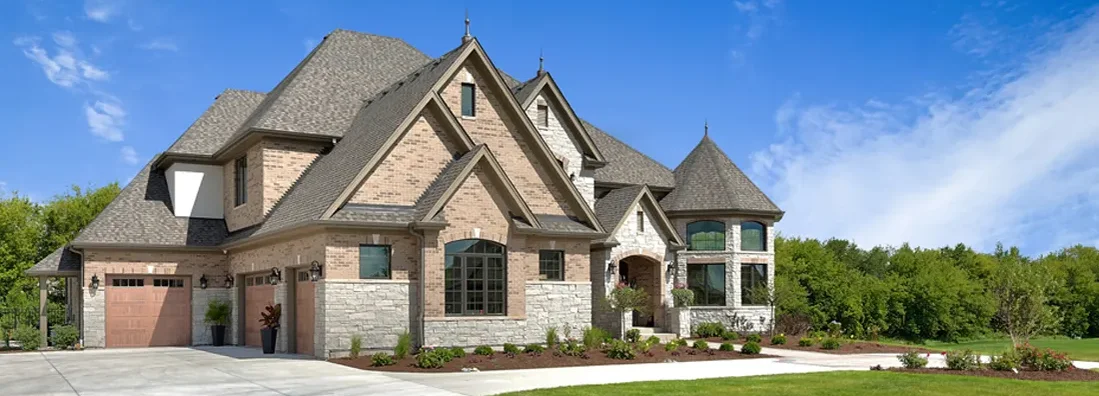Average Cost for Homeowners Insurance in 2023
How much is homeowners insurance?

Jeff Green has held a variety of sales and management roles at life insurance companies, Wall street firms, and distribution organizations over his 40-year career. He was previously Finra 7,24,66 registered and held life insurance licenses in multiple states. He is a graduate of Stony Brook University.

The national average cost of homeowners insurance is $1,211 per year, based on $500,000 in dwelling coverage, $500,000 in liability coverage, and a $2,000 deductible. This breaks down to an average monthly cost of $100.92. But how much does homeowners insurance cost in your area? It can vary based on several factors.
The amount of coverage you need, along with your exact location and its vulnerability to storms, are just a couple of the key factors that determine how much your policy costs. An independent insurance agent can help you find the right coverage for you at the best available price, no matter where you are. So how much is homeowners insurance where you live? Let's break it down further.
Average Homeowners Insurance by State
The chart below shows the average HO3 homeowners insurance premium by state for a median-value home. The chart also shows you how your state ranks in cost.
| State | Annual Rate | Monthly Rate |
|---|---|---|
| Alabama | $2,021 | $168 |
| Alaska | $1,307 | $109 |
| Arizona | $1,614 | $134 |
| Arkansas | $1,531 | $128 |
| California | $1,839 | $153 |
| Colorado | $2,900 | $242 |
| Connecticut | $1,699 | $139 |
| Delaware | $845 | $70 |
| Florida | $2,207 | $184 |
| Georgia | $1,318 | $110 |
| Hawaii | $987 | $82 |
| Idaho | $1,398 | $117 |
| Illinois | $1,856 | $155 |
| Indiana | $1,500 | $125 |
| Iowa | $1,167 | $97 |
| Kansas | $2,265 | $189 |
| Kentucky | $1,571 | $131 |
| Louisiana | $2,058 | $172 |
| Maine | $895 | $75 |
| Maryland | $1,426 | $119 |
| Massachusetts | $1,844 | $154 |
| Michigan | $1,223 | $102 |
| Minnesota | $2,188 | $182 |
| Mississippi | $1,257 | $105 |
| Missouri | $1,492 | $124 |
| Montana | $1,821 | $152 |
| Nebraska | $2,554 | $213 |
| Nevada | $1,144 | $95 |
| New Hampshire | $801 | $67 |
| New Jersey | $1,359 | $113 |
| New Mexico | $1,338 | $112 |
| New York | $1,418 | $118 |
| North Carolina | $1,800 | $150 |
| North Dakota | $1,475 | $123 |
| Ohio | $1,215 | $101 |
| Oklahoma | $2,278 | $190 |
| Oregon | $1,106 | $92 |
| Pennsylvania | $736 | $61 |
| Rhode Island | $1,252 | $104 |
| North Carolina | $1,562 | $130 |
| South Dakota | $1,741 | $145 |
| Tennessee | $2,088 | $174 |
| Texas | $2,536 | $211 |
| Utah | $897 | $75 |
| Vermont | $680 | $57 |
| Virginia | $1,290 | $108 |
| Washington | $1,292 | $108 |
| West Virginia | $918 | $77 |
| Wisconsin | $846 | $70 |
| Wyoming | $1,265 | $105 |
The average premium for your state is a good benchmark to start with. If you're paying a lot more or a lot less, it may be because of the metro area you live in and/or the amount of coverage you have. Talk to an independent insurance agent. They can help you sort it out.
How Much Is Home Insurance in Your City?
Real estate values vary depending on not only your state, but your city. So homeowners insurance costs in your town might be considerably higher than in your neighbor's.
Here are some average home insurance prices in select major cities across the US:
| Major US City | Average Annual Home Insurance Cost | Average Monthly Home Insurance Cost |
|---|---|---|
| Austin, TX | $1,320 | $110 |
| Boston, MA | $1,488 | $124 |
| Charlotte, NC | $1,194 | $100 |
| Chicago, IL | $1,708 | $142 |
| Columbus, OH | $1,139 | $95 |
| Dallas, TX | $2,181 | $182 |
| Denver, CO | $2,024 | $167 |
| Detroit, MI | $2,544 | $212 |
| Jacksonville, FL | $1,063 | $115 |
| Las Vegas, NV | $924 | $77 |
| Los Angeles, CA | $1,385 | $115 |
| Philadelphia, PA | $1,132 | $94 |
| Seattle, WA | $879 | $73 |
| Washington, DC | $879 | $75 |
*Values are based on $250,000 worth of dwelling coverage.
The Most Expensive States for Homeowners Insurance Costs
The annual home insurance cost tends to be higher in states with an increased risk of widespread home damage. This can be due to factors such as higher crime rates or higher risk of certain natural disasters like tsunamis, hurricanes, tornadoes, or earthquakes. Our research found that some of the most expensive states for homeowners insurance premiums are Louisiana, Florida, Texas, Oklahoma, and Kansas. Average costs for home insurance in these areas are much higher than in other states due to the risk of natural disasters (e.g., flooding and hurricanes in Louisiana and Florida). Property values also play a role in a state's home insurance premiums.
The Least Expensive States for Homeowners Insurance Costs
States with a lower risk for natural disasters also tend to have cheaper average home insurance annual premiums. Our research found that a few of the cheapest states for home insurance are Oregon, Utah, Idaho, Nevada, and Wisconsin. According to our findings, each of these states pays less than $800 per year, on average, for home insurance.
Average Cost of Homeowners Insurance Based on Dwelling Coverage Amount
Another factor that impacts the cost of home insurance is the amount of dwelling coverage you need in your policy. Your dwelling coverage provides reimbursement to rebuild or repair your home's structure or dwelling if it gets damaged or destroyed by a covered peril like a fire. Ideally, you need to match your home's replacement value with your dwelling coverage's limit in case your house gets totally destroyed.
Here are some average home insurance cost estimates by dwelling coverage limit:
| Dwelling Coverage Limit | Average Annual Home Insurance Premium | Average Monthly Home Insurance Premium |
|---|---|---|
| $150,000 | $1,194.00 | $99.50 |
| $250,000 | $1,670.50 | $139.00 |
| $350,000 | $2,190.00 | $182.50 |
| $450,000 | $2,773.50 | $231.00 |
The Average Homeowners Insurance Cost by Company
Where you buy your homeowners insurance also impacts its cost. Some insurance companies offer discounts, while others don't. Policies and coverage amounts also vary by insurance company, and some insurers offer bundles and savings not offered by other companies. Our findings show USAA's $250,000 dwelling coverage home insurance policies were the most affordable, with an average premium of just $81 per month, while Chubb's $450,000 dwelling coverage policies were by far the most expensive, at $254 per month.
Here are some average annual and monthly homeowners insurance rates by insurance company:
| Home Insurance Company | Dwelling Coverage Level | Average Annual Premium | Average Monthly Premium |
|---|---|---|---|
| The Hartford | $250,000 | $1,955 | $163 |
| The Hartford | $450,000 | $2,601 | $217 |
| Nationwide | $250,000 | $1,075 | $90 |
| Nationwide | $450,000 | $1,869 | $156 |
| Travelers | $250,000 | $1,202 | $100 |
| Travelers | $450,000 | $2,063 | $172 |
| USAA | $250,000 | $978 | $81 |
| USAA | $450,000 | $1,483 | $123 |
| Chubb | $250,000 | $1,763 | $147 |
| Chubb | $450,000 | $3,045 | $254 |
How Do Insurance Companies Set Rates for Homeowners Insurance?
How insurance companies make money is actually pretty simple. The insurance company takes in money from premiums, invests it, and pays out money in claims. If the money they pay out in claims is less than the money they take in from premiums and investments, the boss is happy.
How Much Does Homeowners Insurance Cost?
So, how much does homeowners insurance cost? Where you live has the biggest impact on homeowners insurance premiums. Premiums are based on the property value. Real estate values tend to be higher in heavily populated places. Resorts, retirement areas, and cities with rapid growth also have higher property values, and higher property values mean higher premiums. Construction costs, building codes, and interest rates also impact premiums.
What Is Included in a Homeowners Insurance Rate?
Homeowners insurance policies include a few core protections to provide reimbursement after a disaster affects one of these major categories. But each of these categories also impacts the cost of your overall home insurance rate.
Here are the main coverages included in most standard home insurance policies:
- Personal liability coverage: If a third party sues you for bodily injury or property damage, this coverage can reimburse you for attorney, court, and other legal fees. Coverage limits typically range from $100,000 to $500,000.
- Dwelling coverage: If your home's structure gets damaged or even destroyed by threats like fire, falling objects, etc., this coverage can reimburse for rebuilding or repair. This coverage is usually equal to your home's rebuilding cost, or replacement cost value.
- Other structures coverage: If a detached structure like a garage, shed, fence, etc. gets destroyed or damaged by a covered peril, this section of your policy can pay to repair or rebuild it. This coverage usually is limited to 10%-20% of your overall dwelling coverage.
- Loss of use coverage: If a major disaster like an explosion leaves your home temporarily uninhabitable, this coverage can reimburse for extra costs like hotel visits, takeout meals, laundry services, etc. Coverage is usually capped at 10%-20% of your dwelling coverage's limit.
- Medical payments coverage: If a guest or other third party gets injured on your property, this coverage can reimburse for their medical costs. Coverage is usually limited to somewhere between $1,000 and $5,000.
- Personal property coverage: If your personal property like clothing or furniture gets damaged by fire, etc., or even stolen, this coverage can help reimburse for replacement or repair. You're likely to pay more for a policy with replacement cost coverage than an actual cash value policy, but personal property coverage is typically capped at 50%-75% of your dwelling coverage.
An independent insurance agent can further explain how each of these components of home insurance impacts your overall policy rates.
Factors That Affect the Average Cost of Homeowners Insurance
Many factors still impact the average cost of home insurance. Here are some of the most common:
Year built
Newer construction usually results in a lower average price for home insurance. Older homes are more of a risk for an insurance company due to their increased likelihood of needing repairs or updated wiring, plumbing, etc.
Roof condition
The condition of your roof is another huge factor that impacts the average cost of home insurance, because insurance companies place a lot of importance on the age and status of a home's roof. One way to reduce your home insurance premiums is to update your home's roof, making your property safer and less likely to experience leaks, etc.
Special features
Insurance companies consider swimming pools, trampolines, zip lines, and more to be "attractive nuisances," or features that could lead to injury. Since these special features are seen as a greater liability risk, you'll typically pay more for home insurance if your home has any of them.
Where you live
Again, your home's location impacts your home insurance rate due to a couple of different factors, including your area's vulnerability to natural disasters. Property values and crime rates are other aspects that factor into average home insurance rates in your area.
Deductible rate
The higher your deductible amount, the lower your average premiums are likely to be. Just keep in mind that a higher deductible means you'll have to pay more out of pocket per claim before your home insurance company starts reimbursing you.
How to Save on Homeowners Insurance
There are several ways you can save on your homeowners insurance monthly cost. The typical cost of homeowners insurance can be greatly reduced by taking advantage of discounts provided by a carrier. Here are just a few examples of common homeowners insurance discounts and ways to save money on your coverage:
- Bundling discounts: Many insurance companies offer generous discounts if you bundle your home insurance coverage together with another policy. A common option chosen by many homeowners is to bundle home insurance together with car insurance.
- Security features discounts: The safer you make your home, the less of a risk the insurance company will perceive it to be. Installing safety and security features like burglar alarms, motion sensor lights, or cameras, can help earn you a discount on your premiums.
- Claims-free discounts: Many home insurance companies reward you with discounts if you remain claims-free for a set period of time. This time period varies by carrier, but often is in increments of a couple years or more without filing a claim.
- Loyalty discounts: Many carriers also reward customers who keep their home insurance coverage with them over time. Some insurers may start to offer you a discount on your premiums if you keep your coverage with them for five years or more.
- Upgraded roof discounts: The more steps you take to improve and upgrade your home, the more you stand to save on your home insurance. Your roof is one of the main components home insurance companies love to see updated, and you can score a nice discount on your premiums if you do so.
If you're thinking about a pool, a trampoline, or playground equipment for the kids, play it safe. Check with your insurance company to see if it will affect your premium or coverage.
The type of homeowners insurance you have will also influence the premium that you pay.
Frequently Asked Questions about Homeowners Insurance Costs
Here are a few commonly asked questions about homeowners insurance and premium rates.
Our findings show that the national average cost of home insurance is about $101 per month, or $1,211 annually. Home insurance rates vary depending on location and other factors, however.
If an insurance company offers bundling discounts, you can save a substantial amount on your home insurance premiums if you bundle your coverage. A popular option among customers is to bundle home insurance and auto insurance together through the same carrier.
Home insurance may be more expensive in your area for a number of reasons. If property values are higher where you live, the cost of rebuilding your home may be more expensive than in other towns, and your home insurance premiums would have to be higher to compensate. But higher crime rates and higher risk of natural disasters like hurricanes can also cause more expensive home insurance rates near you.
There are several common home insurance discounts available. You can upgrade features of your home, such as the plumbing or electrical systems, or the roof, and oftentimes earn a discount that way. You can also install safety and security features such as burglar alarms or cameras to earn a discount.
Find the Best Independent Insurance Agents for Homeowners Insurance
Comparing policy rates by yourself can be complicated and there are a lot of big nuggets to digest. That’s where an agent comes in – they'll know everything that's important to consider when comparing rates.
Our independent insurance agents can make your life all sorts of easier – at least through this process. Since they're not tied down to one insurance company, they're free to shop, compare, and assemble all the pieces of the coverage puzzle for you.
https://www.iii.org/article/what-homeowners-insurance
https://www.valuepenguin.com/average-cost-of-homeowners-insurance
